
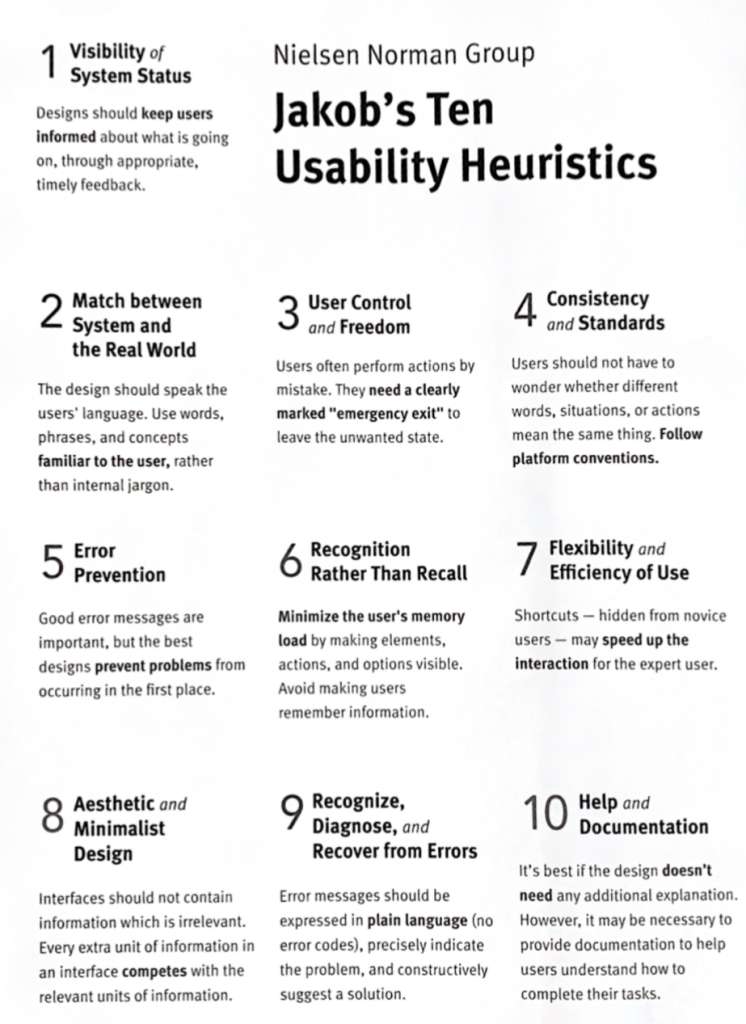
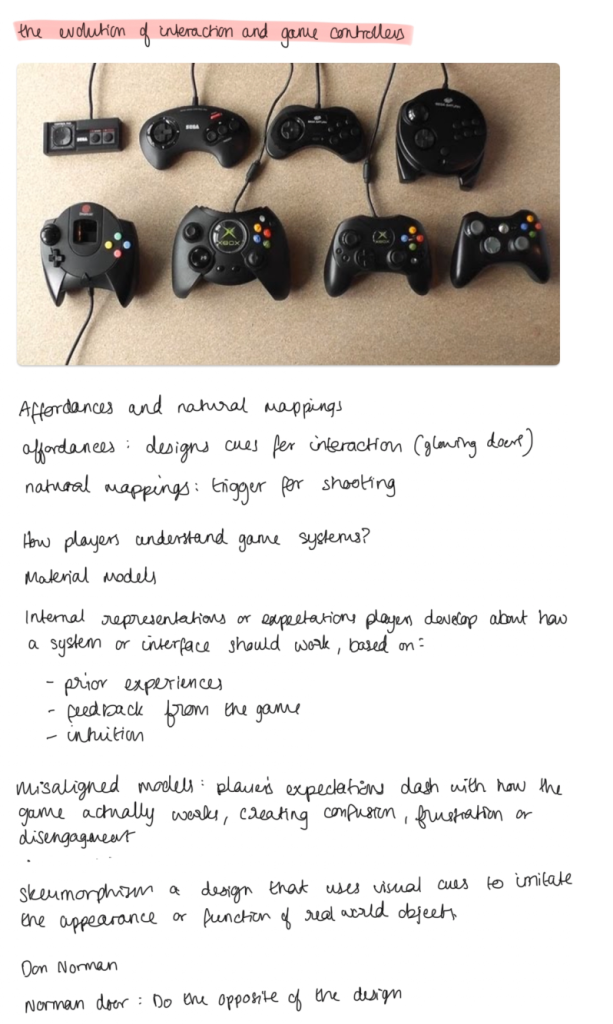



This week, we were introduces to Jessie Saunders, who is a sound engineer. In her lecture, she will be going through the different types of audio we hear when playing games, from music to the little sounds that we as players don’t even notice.
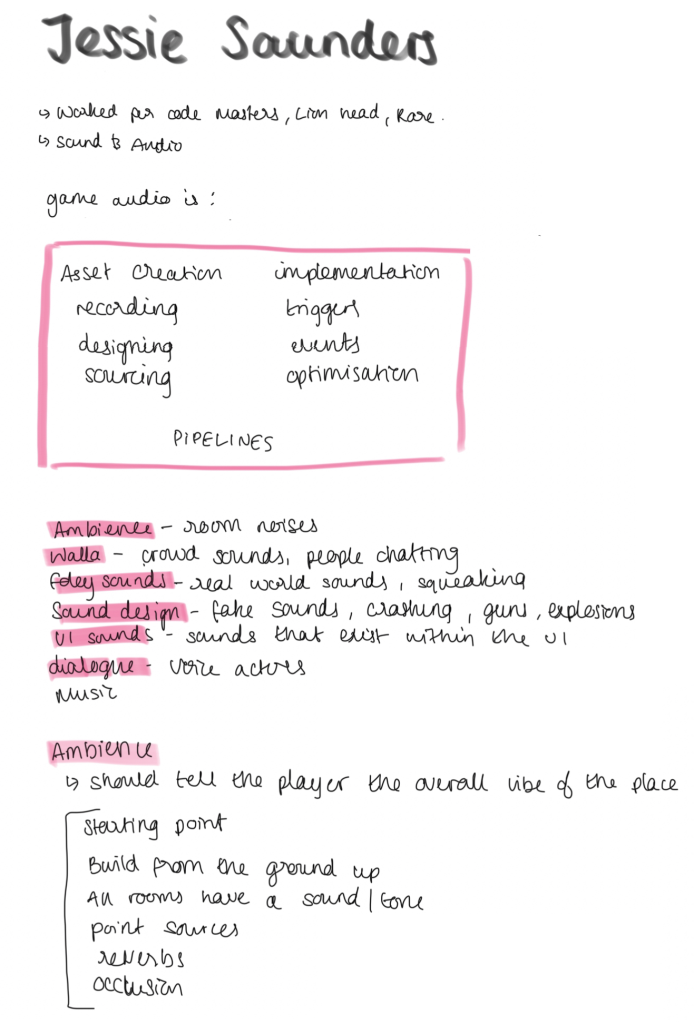
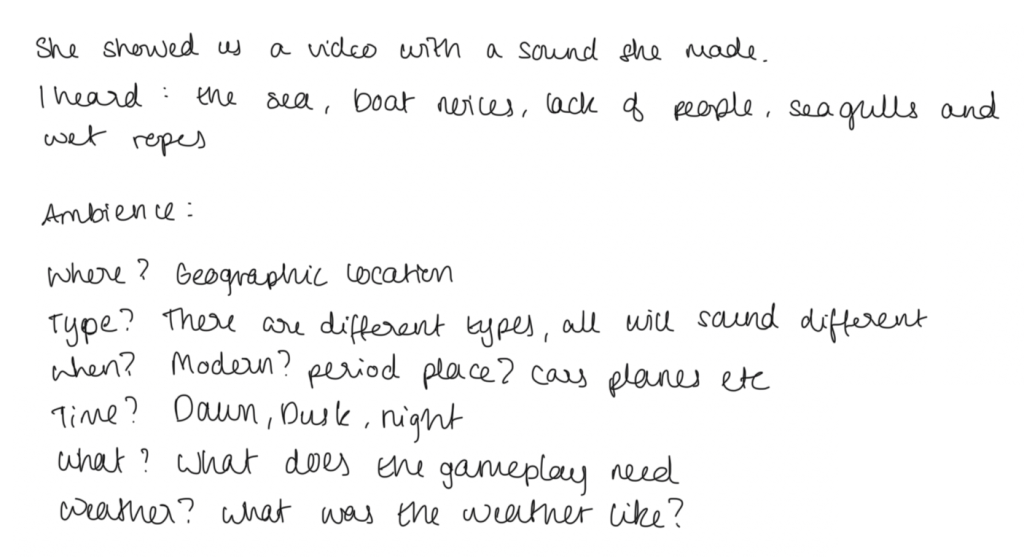
The following notes are the different types of audio we hear;


During this week, we were requested by Venissa to come in and have feedback and see how we are getting along with our games.
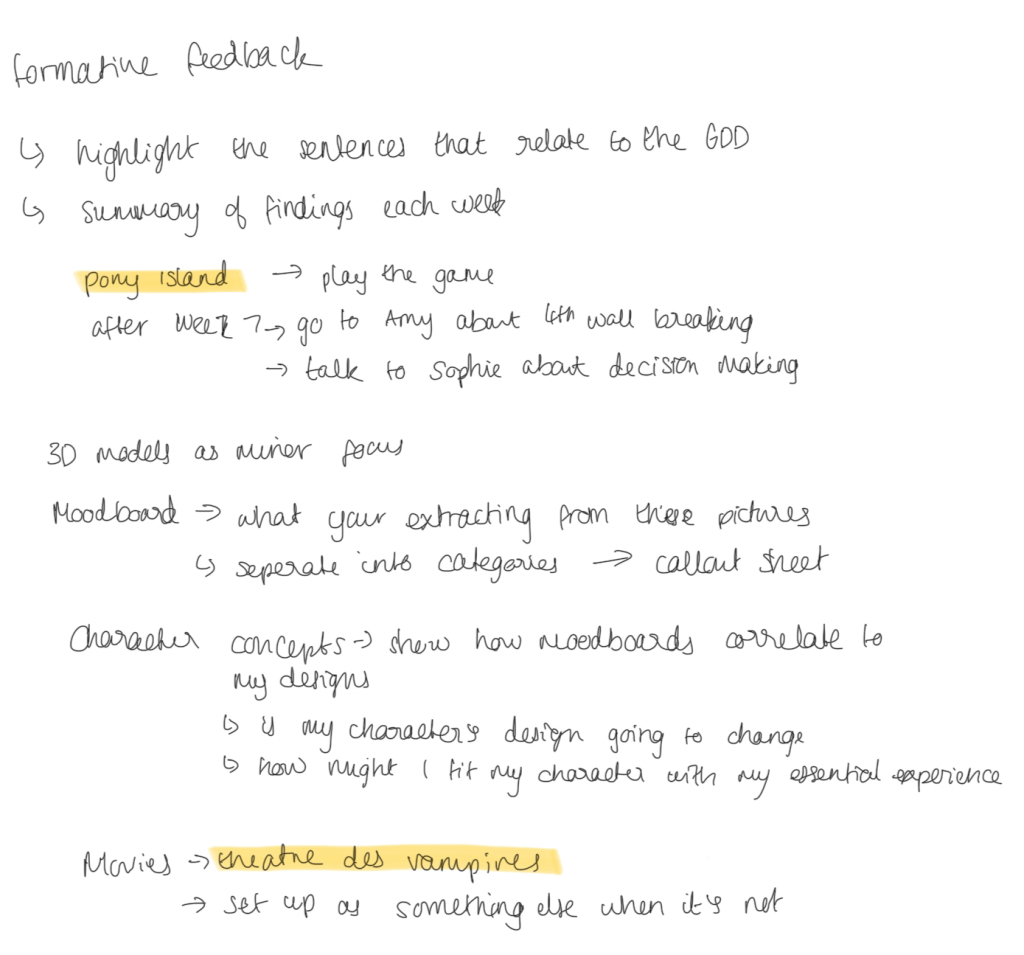
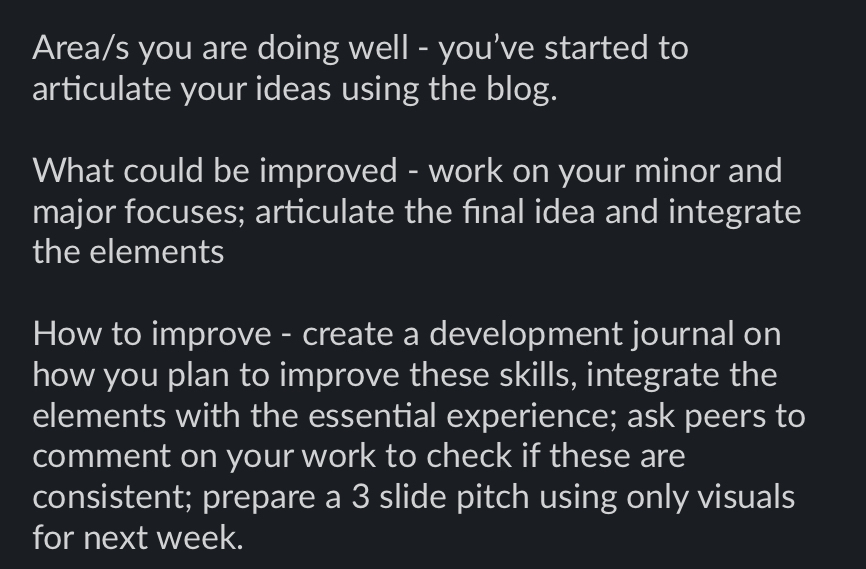
In this week, we were given another guest talk. This time, the lesson was hosted by Venezia. G who is a senior systems designer at Sumo Digital that has designed games for 100M+ players. She will guide us through game systems and the importance of game pillars.
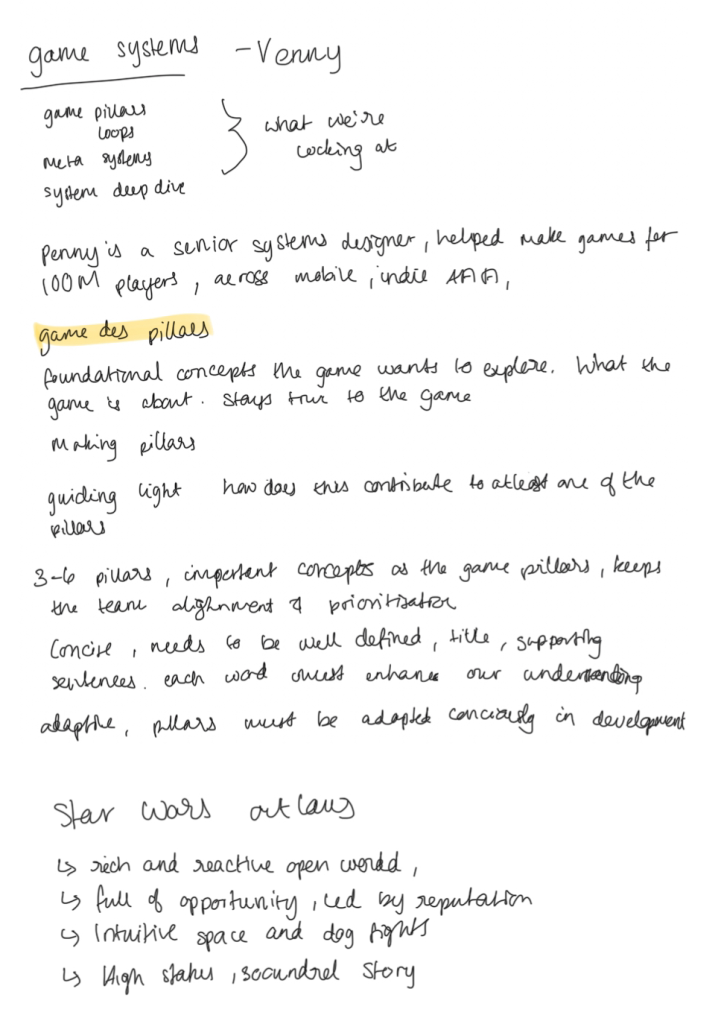
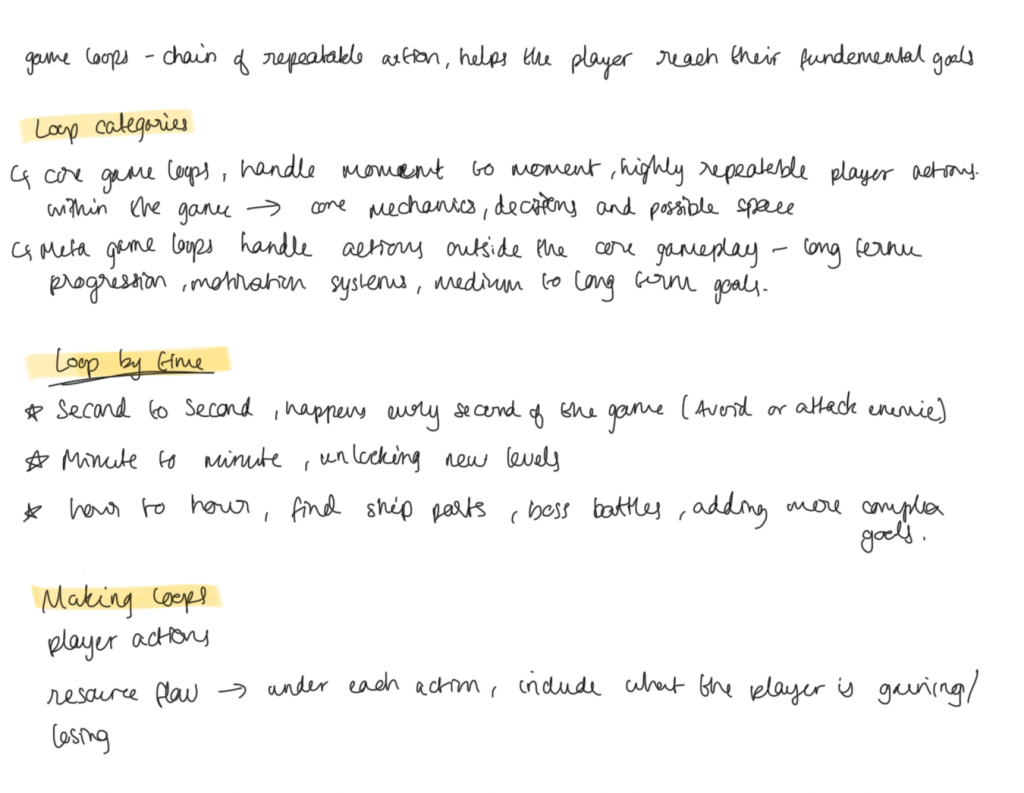
Here is a core game loop Venezia has demonstrated using one of her favourite games, Astrobot. The diagram below it displays the meta game loop.
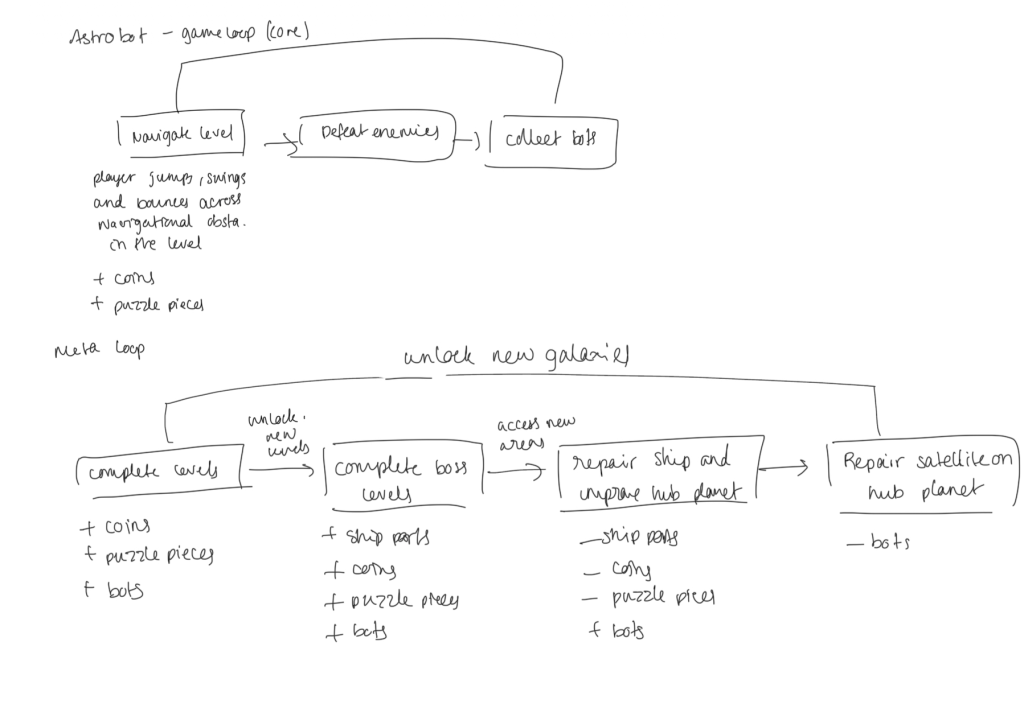
In these diagrams, I had a go at making my own core game loops.
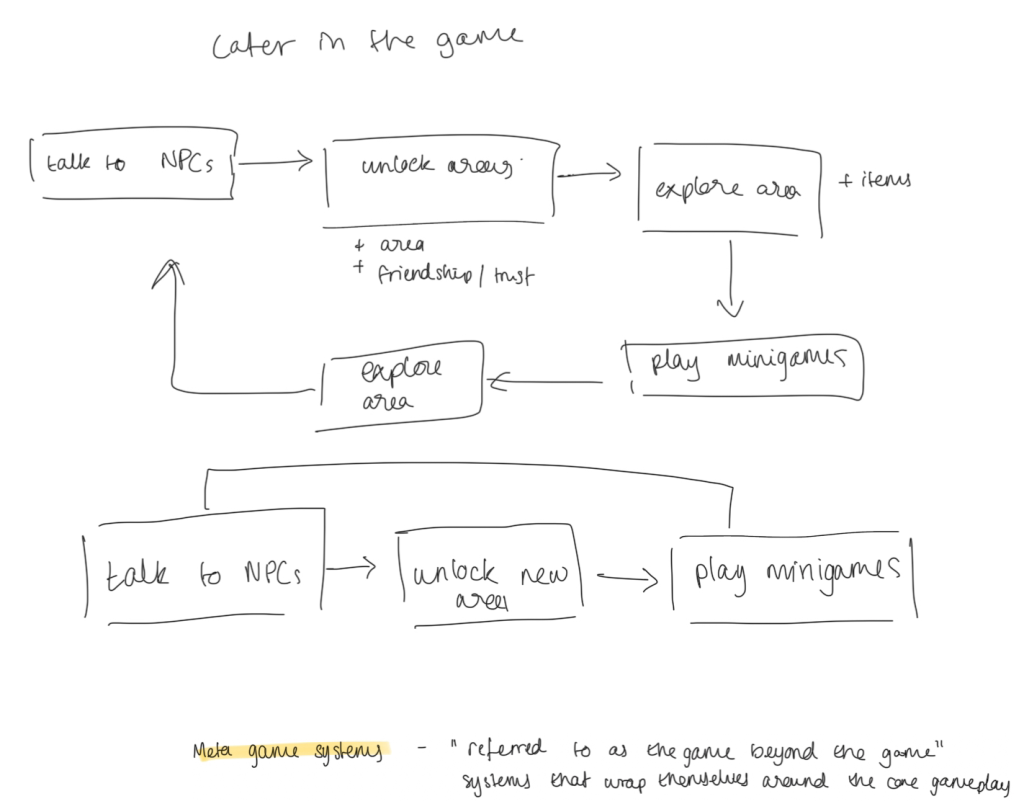
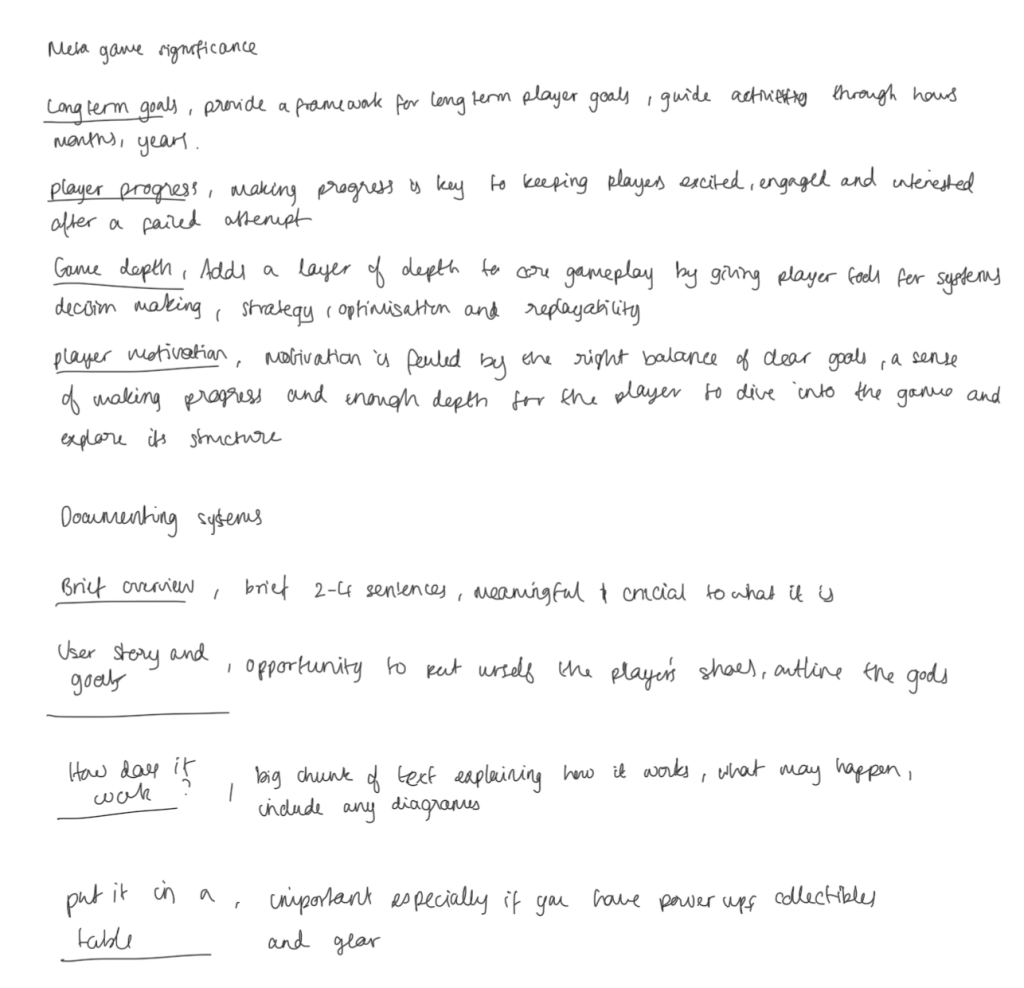
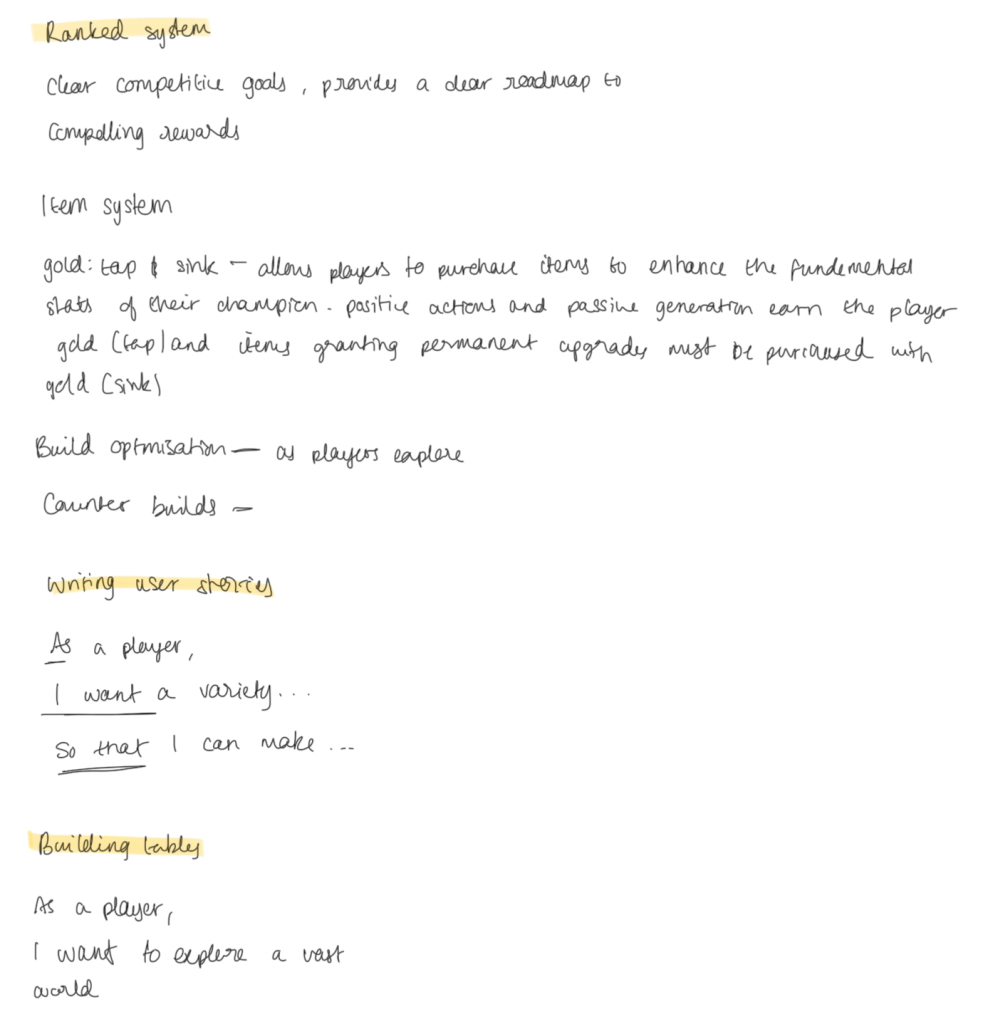
This week, we delved into character design and why it’s important in a video game. In this lesson, I am going to be looking into character pipelines and how to make a unique character.
Why do I need decent characters in a game?
Simple, characters can provide many different things that games with no characters can; They can provide emotional connection or a sense of relatability, players will want to know what is happening with the game world and what will happen to the characters they play as or the supporting cast; It also promotes an immersive experience, unique characters can make the player feel like they are apart of the world and could lead to a more entertaining experience; Finally, by having well designed characters, it offers an interesting story, this encourages the player to keep playing and investigate the world they live in.
There are also several character archetypes:
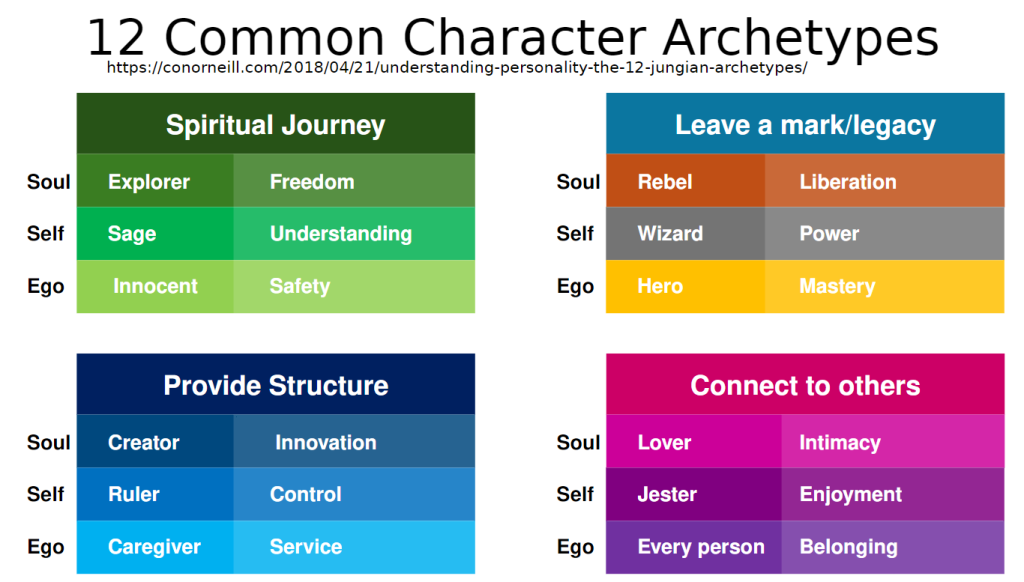
Activity: Focalising character
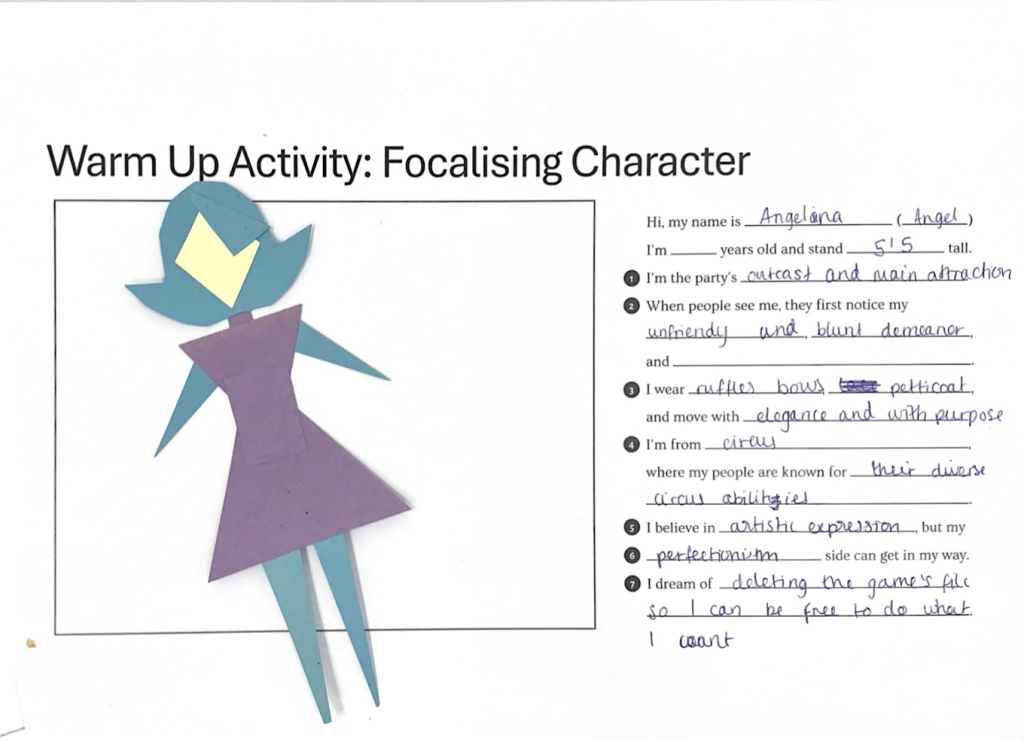
In this mini activity, I based off this character off of an initial concept for my game and thought that doing tis activity would help me add some meat on her bones. Although this task was supposed to be easy, it took me a while to figure out how she’d be like in my game. After that, we were provided some colourful paper and scissors. We were also told to use only 3 colours for this task; We needed to design the character but we could only utilise very basic shapes. This isn’t the character silhouette I had in mind, but this activity could prove useful in the future once I start coming up with initial character concepts.
Moving on, we looked at shape language and how that translates to the eye, how different lines and curves can mean different things and how to make images look more lively:
Body shapes in character design:
| Circles | Squares | Triangles |
| Innocence, youth, energy, charismatic, endearing, harmless and friendly | Maturity, stability, balance, stubbornness, reliable, uniform, traditional and professional | Aggression, force, cunning, dynamic, competent, downward triangles are especially aggressive. |
Jake Detonator
This week, Jake came to teach us again, this time he taught us more about character design in depth. To recap, Jake visited us last week and briefly brushed on concept art, he is an illustrator, author and a graphic designer.
In this lesson he talks mainly about character design and how to emphasise your characters further through their posture, aesthetics and facial expressions.
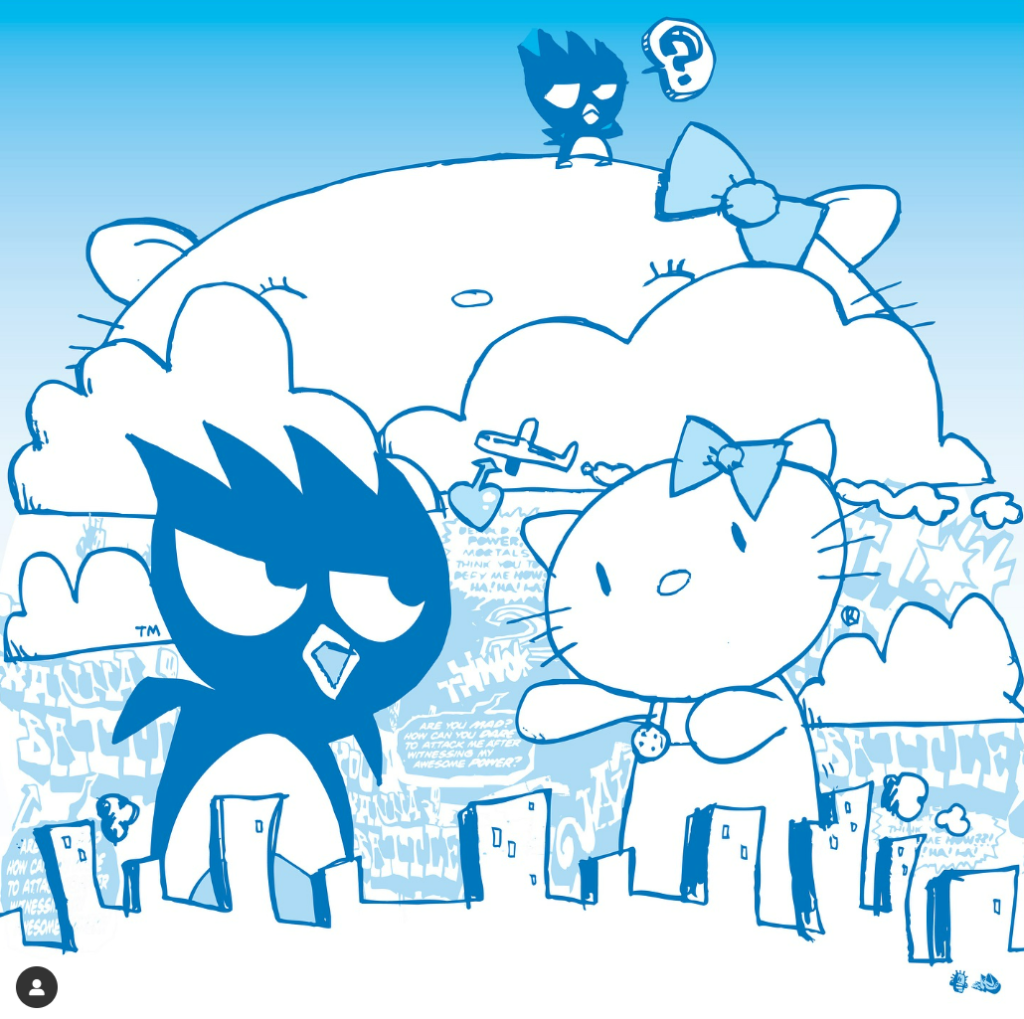
Narratives
A narrative doesn’t have to be spoken or written, it can also be told through a series of images. Narrative photography is telling a story with the use of pictures. It is also referred to as story photography, and often takes the form of a photo essay.
Three act story:
Introduction (beginning): This is where the story is set up
Confrontation (middle): This is the biggest part of a story; many events can happen in this act.
Resolution (end): This is the grand finale
IMAGE HERE
Narratives follow a path, when you lay them out and take a closer look, you may notice that they look like a shape, narratives aren’t always linear.


Activity: Deck of stories
In this workshop, our focus was to understand narratives and how powerful this device is if used correctly.
In this activity, we were given miniature booklets with pages of storyline but these pages didn’t make sense if they were placed next to each other. It was our job to unscramble these pages and make a story out of them. Me and my partner were given the story of Adam and Eve; But as we were short on time, we were advised to draw 5 pages of the story and re-order them to make them somewhat make sense.
The pages that I drew, didn’t flow together well. However, if we made a somewhat believable chronological story, it would flow better. These are the results we came up with.

The second activity required us to make a story compromising of 10-12 pages. There are a variety of fairy tales to choose from but me and my partner ended up choosing the story of Goldilocks and the 3 bears. For this activity, to make things easier for us, we needed to write down a beginning and an ending. Everyone knows how Goldilocks begins; She is lost in a forest and is rather peckish, that’s when she finds a cottage in the woods. The story infamously ends with Goldilocks running away in fear from the bears after they find her. Now that we had pinpointed the two main storyline pieces, we needed to write down what comes in the middle. My partner worked from the end towards the start and I worked from the start going towards the end. This way, we got work done more efficiently. We finished relatively quickly, here is what we produced by the end of the workshop.

Amber Boothe – Guest Speaker
In this lesson, we were guided by Amber Boothe and taught to make a mystery game, utilising narrative skills and team work.

Anna Boothe is a freelance writer and a graduate of Curtis Brown Advanced Crime and Thriller’s Course, here she was awarded a full scholarship. She is also one of the mind’s behind the business “Nobody’s Fool Mystery Games”. She is the primary creative writer and designer, putting ideas on paper and receiving feedback.
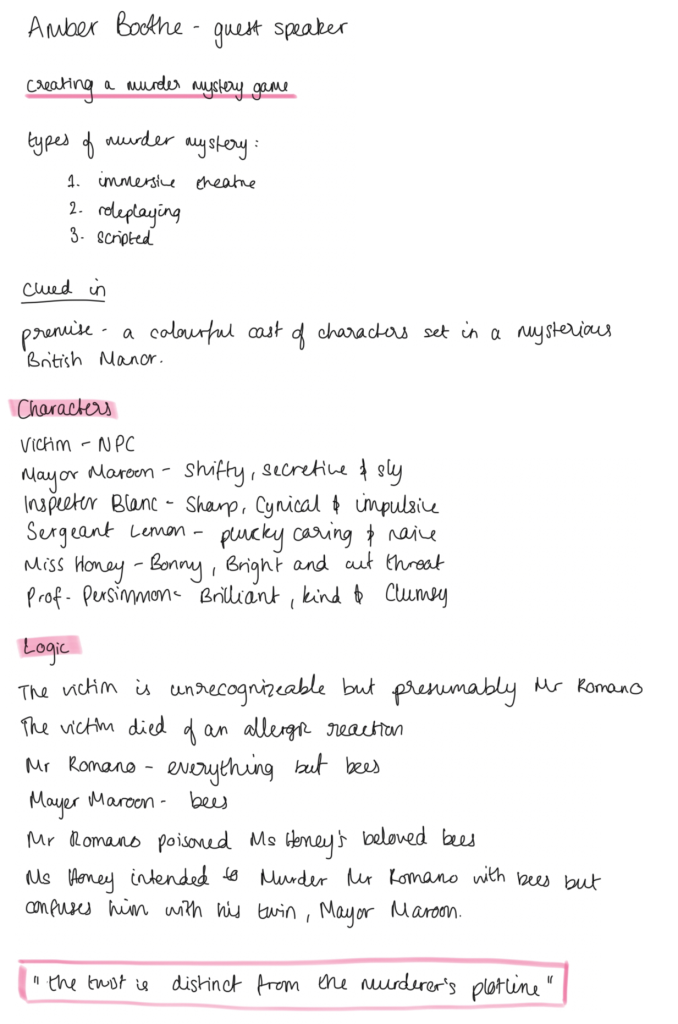
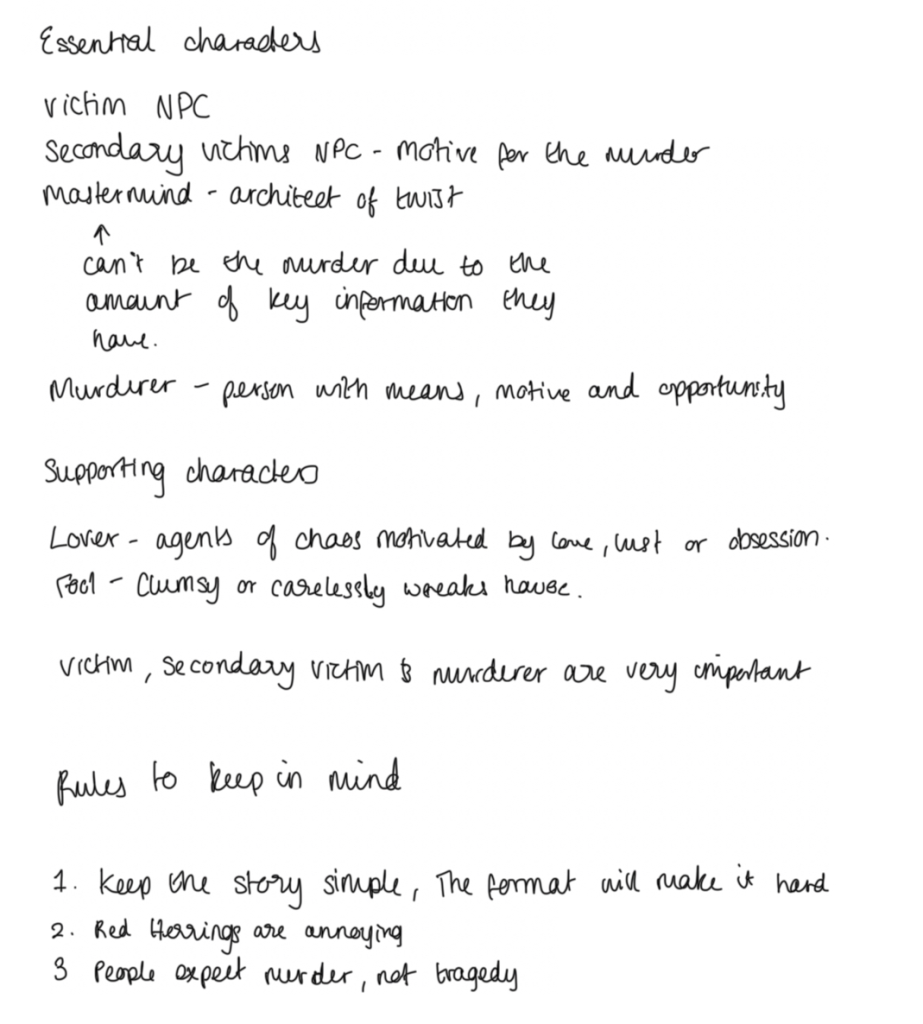
As the lesson progressed, Amber got us to engage in a task. In groups, we needed to make a murder mystery game with characters and their archetypes and the logic behind certain actions and interactions within the characters. My group came up with a theme revolving around social media and decided to make it campy to add to the irony.
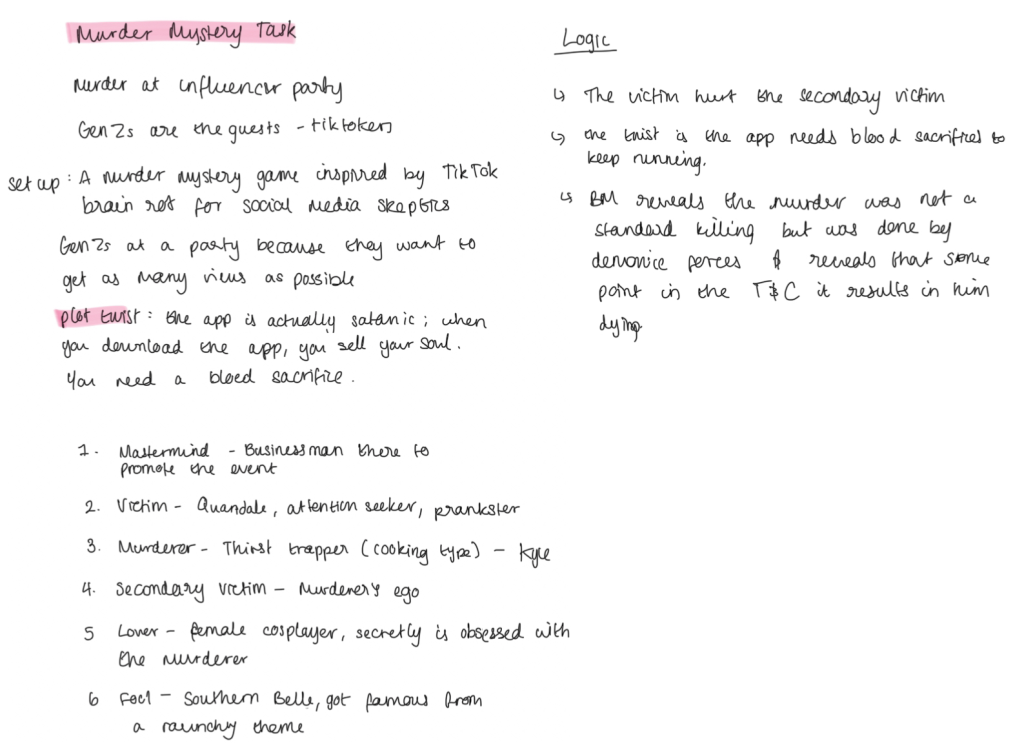
In this workshop, we focused on looking into our essential experience and and further developing them into a more sophisticated idea(s).
After giving us time to produce a mind map of our game theme for this semester, it was time to start thinking about our game’s essential experience more in depth. This workshop explores what we want to express in our games and how we will do that.
The first thing we were told to think about was what type of experience we’d want to give and a verb. E.G. To have the feeling of overcoming demons from an unbalance environment. To make the player thoughtfully consider certain aspects of life. At this point in time, I hadn’t nailed down the main events in my game but I did know for certain that I wanted to make a psychological horror game. In these types of games, it’s common for the player to feel a sense of dread.
What do you feel when you look at these images?

When coming up with your game’s essential experience, think about these questions:
Activity 1: Behaviours and experiences
In this exercise we needed to use physical materials and write down what we want our players to experience
IMAGE HERE – I want my player to feel a sense of unease and pity
What do I know about feeling these emotions? But first, let’s define these emotions; When a player feels unease, they might feel uncomfortable with a certain event or a character and when a player feels pity, they can empathise with a character and understand why they have chosen a certain path. The factors that influence these emotions are the storyline, events that take place, and the characters. The smaller things that some may not think about too much in depth are the sounds, or lack thereof and perhaps small decorations in the background. One thing I want to research in depth is my essential experience; When I start doing it, I may want to ask myself, why do people feel unease in certain situations and ask myself, when have I ever felt pity for something or someone?
Activity 2: Emotion wheel

We were also given out a handout of Dr. Robert Plutchik’s Wheel of Emotions. This image shows a wheel of different emotions that fan out into other emotions. After looking at this diagram, we were instructed to write down what our essential experience is on a post it note and stick it on a grid with 4 different emotion states at the points.

Activity 3: Play structures
At this part of the lesson, we started to look at play structures and how we can apply this to our essential experience. Pay structures and a metaphor for level design that can assist a variety of play.
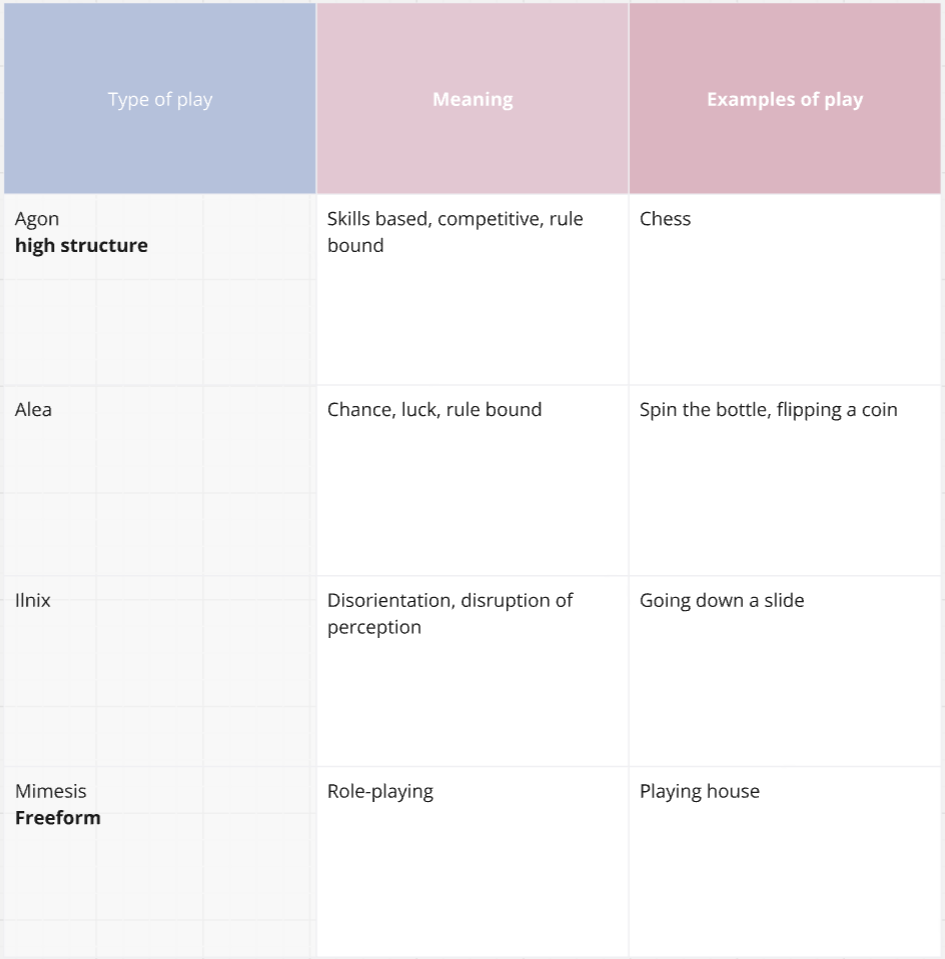
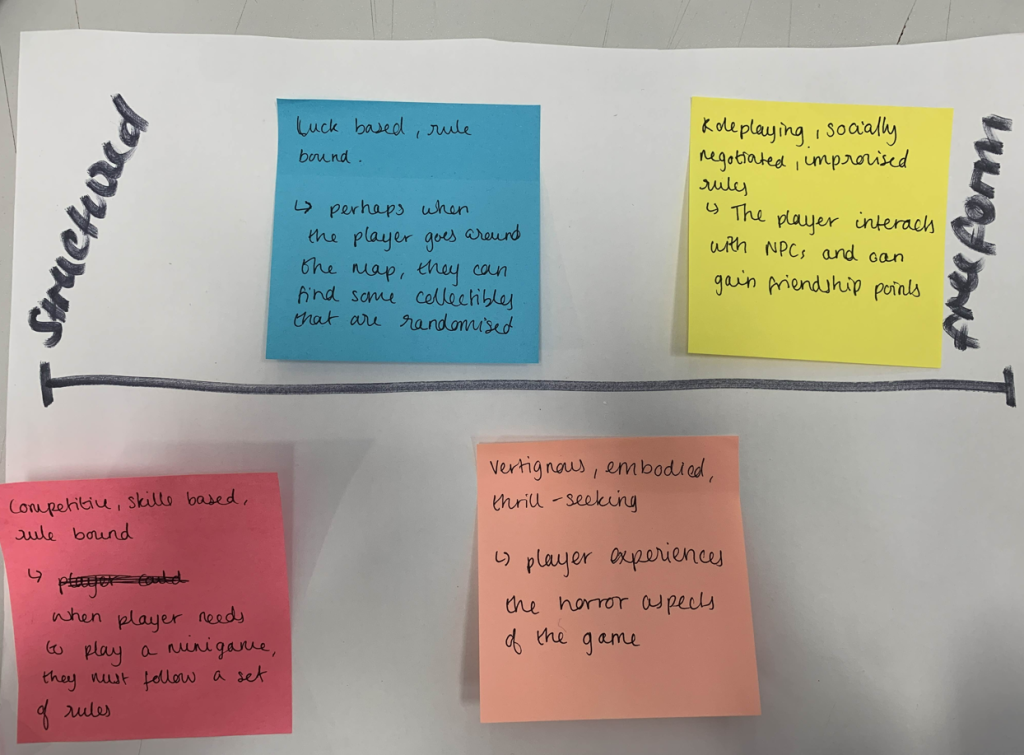
Concept art
On Thursday we looked at concept art and were given tips about concept art before we start producing it ourselves. In art, there is so much more to art than technical ability, as artist we need to remember:
There are also different ways to produce reference sheets for your character:

Reference sheets are very important to an artist, especially if the concept is outlandish and fantasy based. When I produce character art / general concepts my first instinct is to head over to Pinterest and stick them on a PureRef document, mainly when I’m on my computer and need body pose refs. I have done many pieces of work where I did not have references and the art piece would always take very long, the end product would also not look its best. In conclusion, reference sheets should be made with careful consideration and not images you randomly find, sometimes reference sheets take a while to make and that’s ok! Reference sheets give you the power as an artist to elevate your work further, it can help with anatomy, colours and perspective.
Examples of concept art:
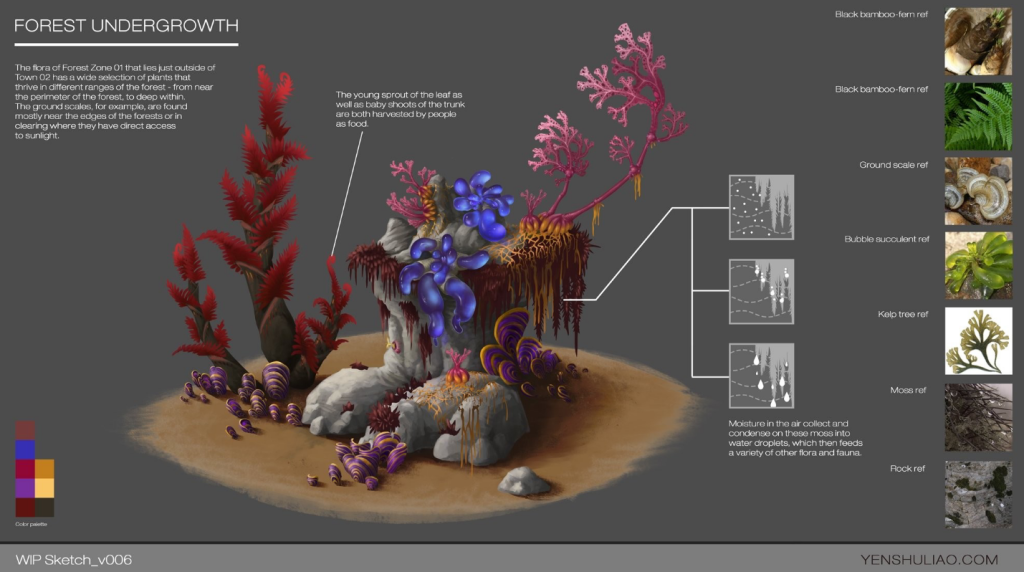
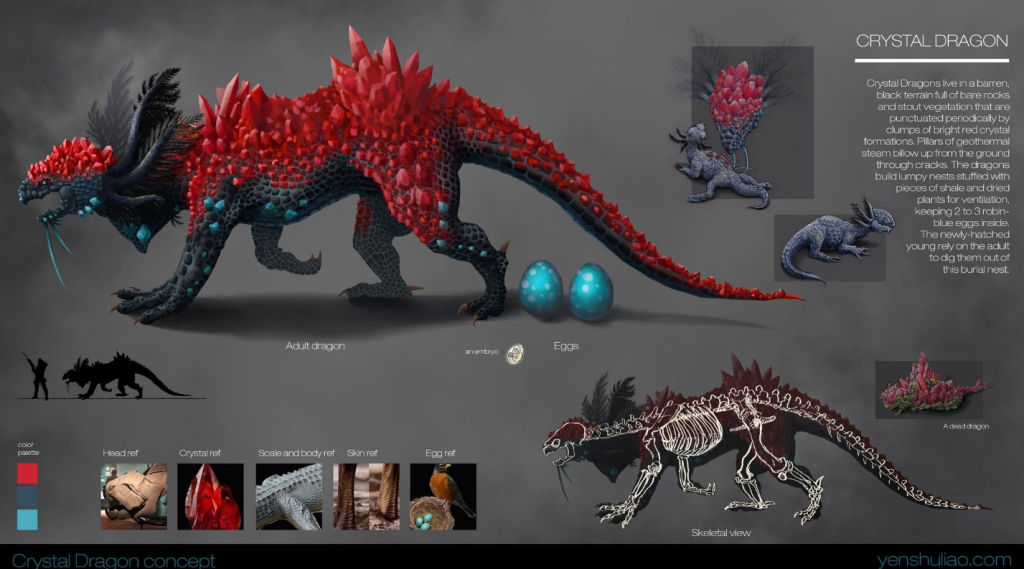
The last thing we looked at today was colour language and how important colours are to pieces.
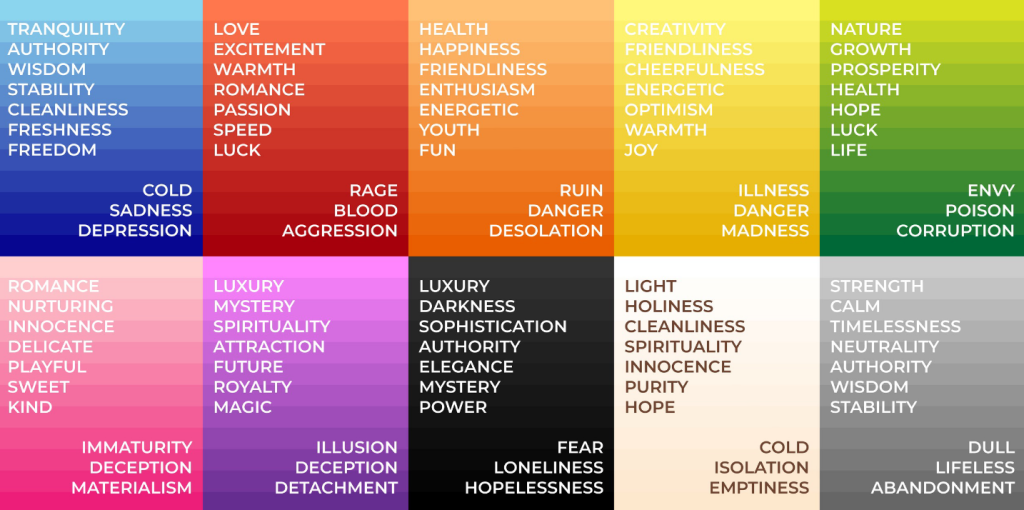
World Bible
This week, we focused on making ideas for our game and the topic for the next coming days will help us figure out what our plan is. In this workshop, we will be delving deep into devices such as world building and world profiles
(The highlighted are the phrases I have added)
Your story begins a top of a floating island, in the clouds, above a wasteland. From the flying pegasi pigs to the glittering azure waterfalls, you’ll find the art of healing spells. In this world, magic is abundant, danger is scarce and daily life is peaceful and easy going. (It’s a lot like something from your wildest dreams). People here are hopeful that the wastelands below them will be purified, but the blight curses the wastelands, making it hard to cure.
Adventure hook
You are a wandering witch/warlock, you travel the skies to strengthen your spells and magic abilities. However, at your stay you got yourself into some trouble and now a prisoner in this island, the only way you can get yourself out is to purify the wastelands below the islands.


Oguz Doma – Guest Speaker
By the end of the week, we were introduced to our first guest speaker, Oguz Doma, who gave the class some insight on architecture and how it can be implemented in video games and VR.

Oguz worked for a project called Dreamscape Bricks VR in 2019-2022 and another project on VR called Black Diamond VR, which is a health and safety vocational training application for underground coal miners. On this project he was in charge of the game design and art direction level.
This game was developed with serious artistic direction as this game was needed to enhance the safety arrangements for underground coal mining. Black diamond VR allows miners to experience different scenarios.
In his lecture, he explains that fictive spaces and video game spaces differ. But how can they differ from each other? In video game spaces, the player can interact with their surroundings and if the game world is in peril, this also gives the player a sense of agency as well. However, this can’t be said for movies and other pieces of media because as the viewer, you aren’t experiencing the plot, you are observing.
In this part of the lesson Oguz goes into depth about the importance of creating realistic environments by using real life references and what could happen if we do not use references.
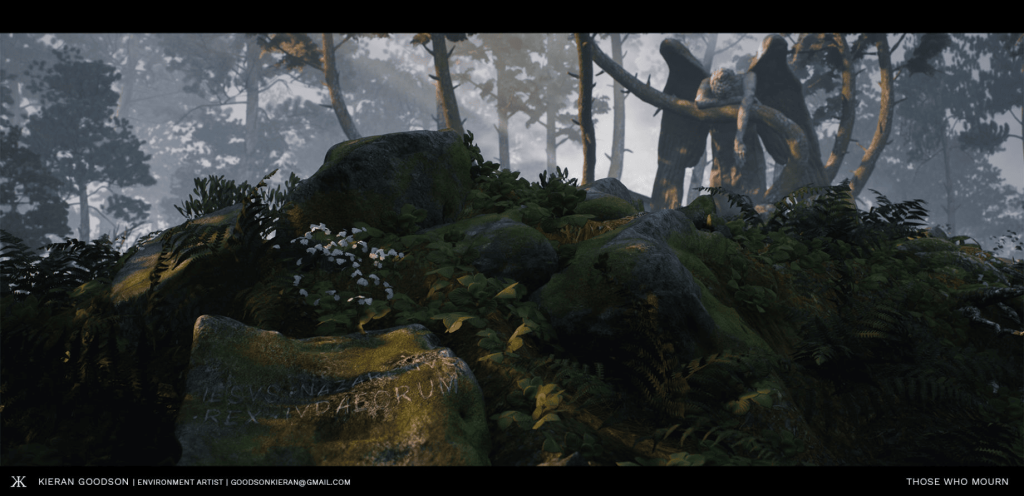
This image shows a well modelled environment of what looks like forest. As we can see, the modeller has utilised biome-correct plants and fauna to enhance the image.
(Kieran Goodson, 2019)
Likewise, if we choose to not have references, we will have a harder time to come up with a geographically correct environment; it also just doesn’t look nice. As we can see, the image here has mountains with snow and it looks fairly low latitude.
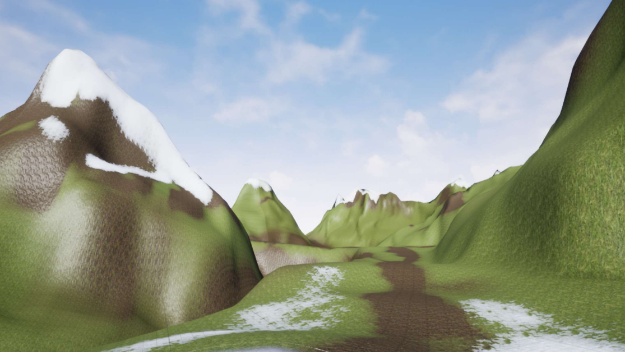
Afterwards, we were given a mini task involving the triadic structures breakdown for a piece of media that hasn’t been turned into a piece of fiction yet. The triadic structure follows this hierarchy:
| Environmental | Game play elements | Visual and sensory details |
| feel and aesthetic of the game and key landmarks | The game’s obstacles, enemies and interactive objects | Lighting, Colours and sounds |
I chose to break down a Webtoon’s world: Siren’s Lament. This story takes place almost entirely in the sea, the main character of course spends most of her time in her flower shop for the first few chapters but as the story progresses, she spends most of her time in the ocean.
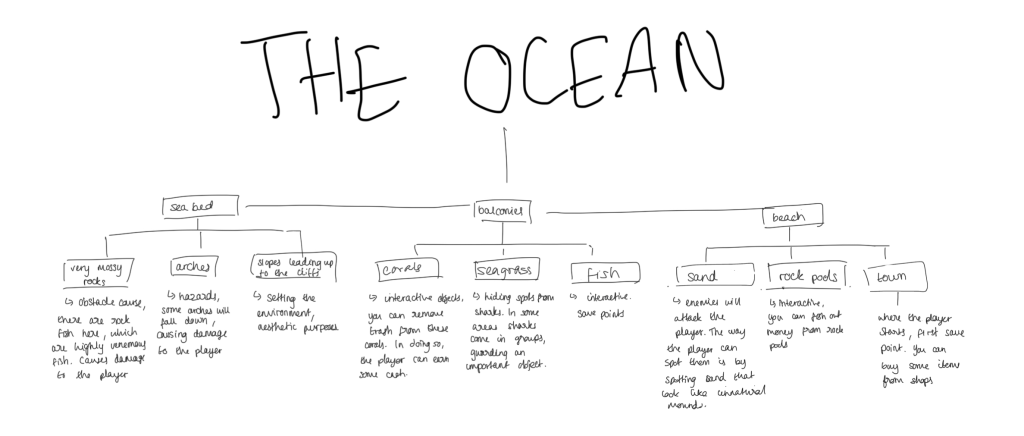
Defining a GDD
Our first lesson back, we were greeted with our brief and what we had to deliver for this project. Today, we glossed over very lightly what a GDD is and I took it upon myself to look at two other GDDs.
A games design document or a GDD is a file that contains the necessary information that outlines the game’s main elements, mechanics and aesthetics. This is needed for a development team when the game is being distributed or made. But what is in a GDD? A GDD consists of a pitch, gameplay, mechanics, elements, assets.
In this workshop, we were given a worksheet to complete in groups. We had to create a logline that acted as the foundation for this task, this logline was a combination of:
As my name begins with the letter P, and I had a myriad of different adjectives to select from: Perfect, paranormal, paranoid, pastel, pleasant etc. I ended up choosing the word “paranormal”. My birthday month is November so the game genre would be a tower defence game and I was also born on the 13th meaning my setting would be a Venetian masquerade ball. The logline that was generated for me was paranormal, tower defence and venetian masquerade ball.
My group ended up choosing my longline and from there on, we started to develop this idea further. Eventually my group came up with a simple story and game mechanic idea, it goes as follows: As the player, you are here to protect the masquerade ball folk (that also happen to be cute animals) from the undead trying to sneak their way into the party. You protect the party go-ers by placing down towers that are orchestra themed, each tower does varying damage and reload times. When you click and drop these towers, they play a note of the instrument they’re holding. I liked this activity because it welcomed me back into the course with ease, it was a nice task that me and my group got done although slow at the beginning, fast once we knew what we were doing.

Now that I had a general idea of what a GDD is, I had a look at different GDDs and made notes about what they had in them, to further help me with making mine later down the line.

Summary of findings
After reviewing both GDDs I feel less intimidated to make one myself now. From what I have gathered from this research to make a successful and concise GDD, I will need to start off with an introduction to my game that lasts roughly 30 seconds and include the genre of game, my demographics and how long it would take. I need to talk about the actual gameplay itself, the goals of the game, the desired outcomes and the undesired outcomes/how the player loses. How the game’s story plays out and the in-game UI. Similarly, I will need to talk about the mechanics and go into depth about the game’s “laws of physics”, what buttons do what, the combat system (if there is one) and what happens to the player if they get damage. I will also need a category on game elements, this goes through the story’s history, politics, the main story, characters, NPCs, locations, environment design. In regards to assets, I will cover briefly on music, SFX (Give examples/Youtube links) and props.
Essential Experience
The following lesson, we were introduced to what an essential experience is and to help us understand it in more detail, we also did a mini task.
Essential experience are the emotions that the player is going to feel, impacted by the events that will happen in the game. For example, when a player finds treasure, they may be ecstatic and when they defeat a boss, they may feel triumphant.
In this exercise, I have created a game pitch that is something personal to me and my life and outline the essential experiences. The first thing that I thought of was my childhood and transforming that into a game, then I remembered a core memory from when I was really young and when my little sister was still quite clingy to me. I think most older siblings find this relatable when I say, that their younger siblings at one point during their childhood were following them around the house, bothering them and repeating the same sentence again and again, “Play with me! Play with me!”. I decided to turn this core older sibling memory into a game mechanic.
This game is a horror hide and seek, as the older sibling you’ve been put in charge whilst your parents come back from work. However, you want to stay in your room to play on your pink Nintendo DS playing your favourite game, Cooking Mama. But there’s one problem… Your little sister wants to play with you. You need to hide away from your sister by finding hiding spots in the house. She’ll look around the room very briefly before going back to play with her My Little Pony figures. During this time, you mustn’t move, control your heart beat and shut your DS off or she’ll see the light. For these mechanics, I thought about the player having to complete a mini rhythm game, where they have to click their mouse at the right time; kind of like how Roblox DOOR’s mini game when the figure finds you in the closet. If the player fails, your sister’s suspicion bar goes up a tiny bit.
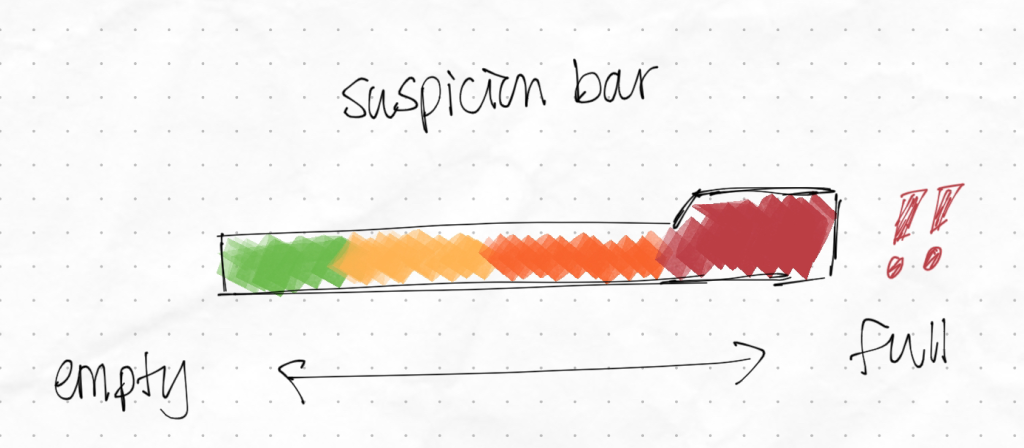
When she leaves, you can go back to playing on your DS, but remember to find somewhere else to hide, you can’t hide in the same place again or her suspicion level will increase significantly. In your house, there aren’t that many hiding spots so you’ll need to resort to using pillows, blankets and laundry you can use to hide yourself in; make sure to properly conceal your body though. As the rounds go on, you will be given more time to hide however, objects to hide yourself will be harder to find. The player loses by either filling up the suspicion bar all the way up or by getting caught by your sister. The win conditions are surviving the night, wait for your parents to come back from work.
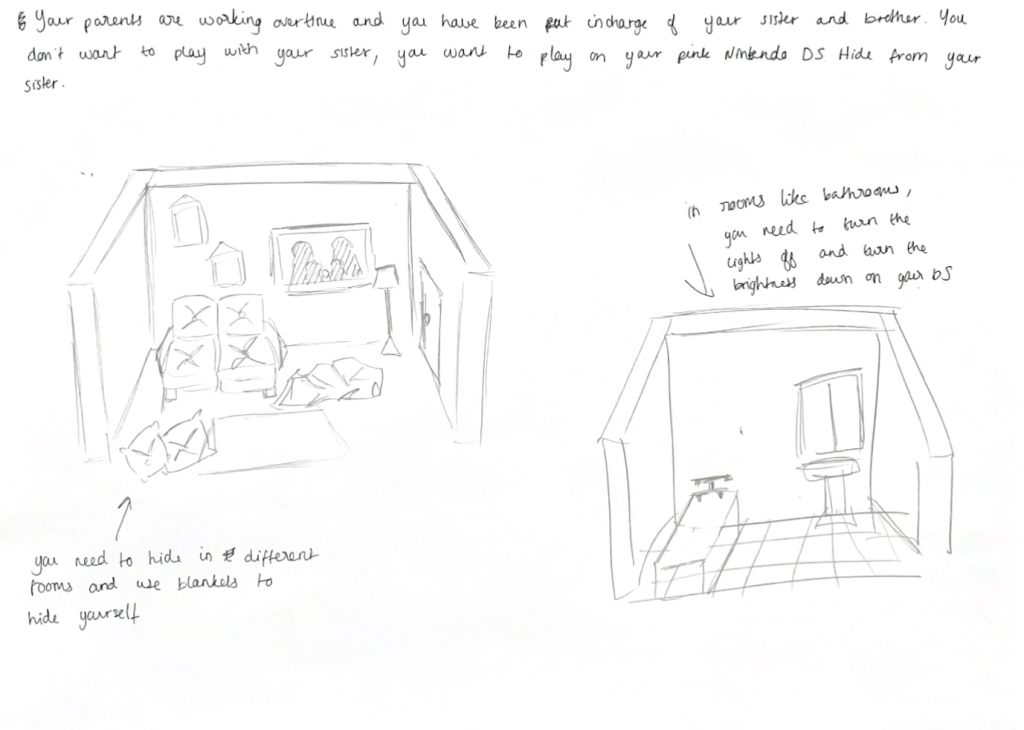
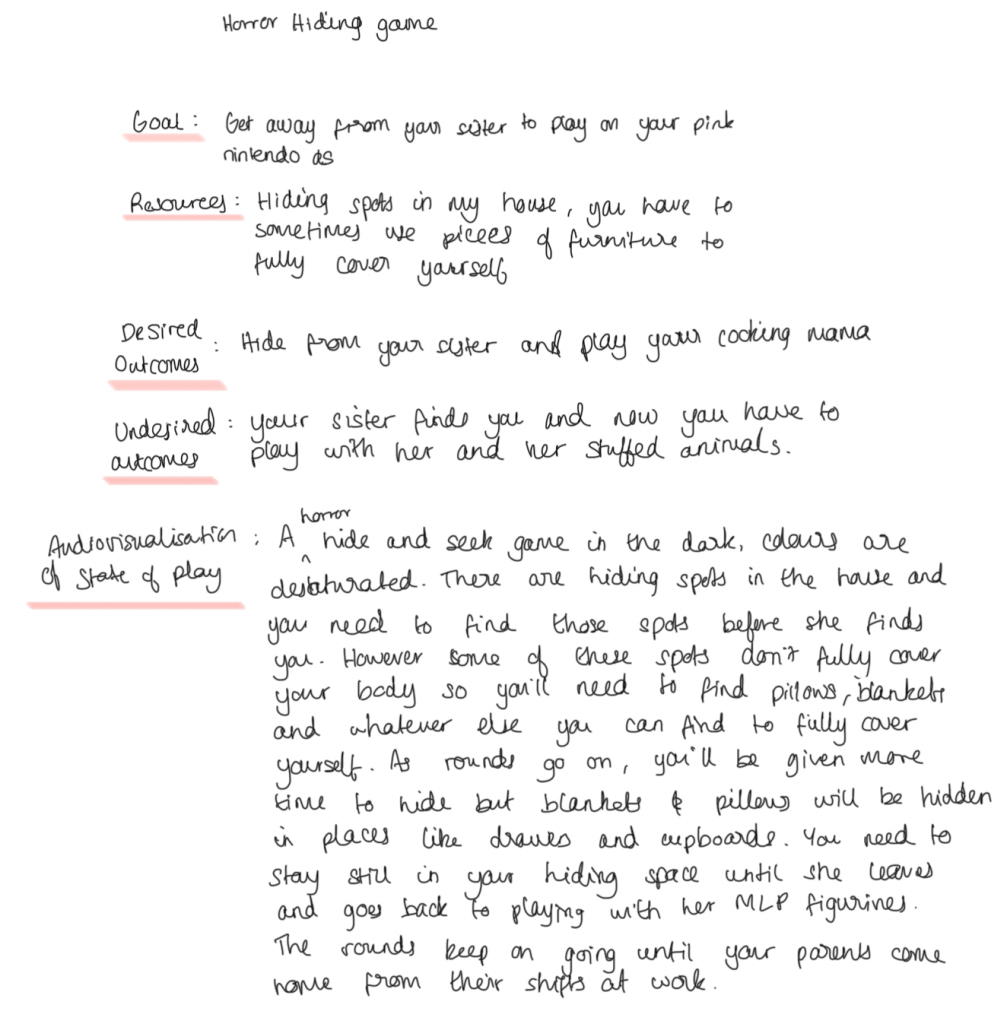
Experiential Metaphor or State
An experiential metaphor is a metaphor that is based on our physical experiences with the world and how we correlate the locations with our feelings.
Metaphors can be made into game mechanics, for example, walking on egg shells can be made into a sneak and stealth game where the player has to quietly exit a dragons nest without stepping on any eggshells. In this activity, we were given a worksheet to complete. What we had to do was pick a metaphor on the board and transform them into a game. Me and my partner chose the phrase, “letting someone off the hook”.
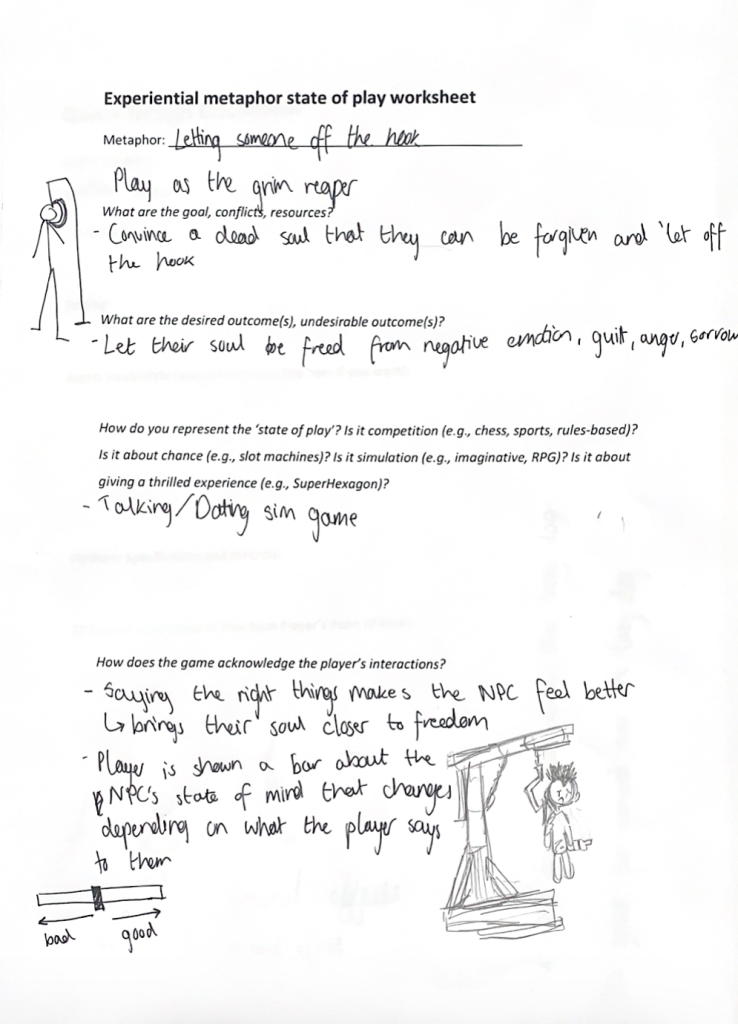
In this game, you play as the Grim Reaper and the game takes place in hell. Your job is to convince lost souls that they can be forgiven and “let off the hook” in a figurative and literal sense. By letting someone off the hook, they can be freed from consuming emotions, but if you fail to do your task, they continue to burn in the fires of hell. It’s similar to a dating sim in the sense where you as the player has to say the most favourable sentence to the soul, to make them feel better. The player is shown a bar of the soul’s state of mind and this bar changes depending on what the player says to them.